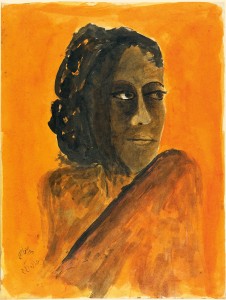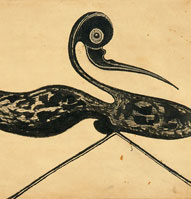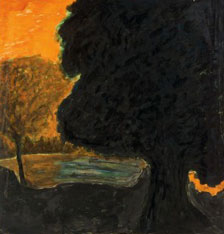Home / Introduction
Introduction
There are some who are insularly modern, who believe that the past is the bankrupt time, leaving no assets for us, but only a legacy of debts . . . . .It is well to remind them that the great ages of the renaissance in history were those when men suddenly discovered the seeds of thought in the granary of the past. The unfortunate people, who have lost the harvest of the past, have lost their present age.
—Rabindranath Tagore, from Centre of Indian Culture, 1919
Rabindranath Tagore (1861–1941), a transformative figure in the modern cultural history of India, is remembered as a poet, playwright, musician, and philosopher, and is also recognized around the world as the first non-European recipient of a Nobel Prize for literature in 1913. Rabindranath Tagore: The Last Harvest commemorates the 150th anniversary of his birth by celebrating Tagore’s work in visual art, an area of creative influence that has been surprisingly underrepresented in remembrances of his legacy. The exhibition comprises more than sixty works on paper produced by this versatile and prolific visionary, drawn from three collections in India, the majority of which have never been seen before in the United States.
Tagore began drawing and painting at the age of sixty-three with no formal training, although several members of his family were educated in art. His artistic practice grew from his habits as a writer and a poet; revision marks and scratched out words on his manuscripts became free-form doodles. The constant working of Tagore’s mind may be seen in the unfettered flow of lines, free choice of colors, and moods that are at times whimsical and at others pensive.

Untitled (Woman’s head against bright orange background), 1937 Colored ink on paper 13 1/4 x 9 7/8 in. (33.6 x 25.1 cm) Rabindra Bhavana, 00-2514-16
For Tagore, rhythm was the essence of his drawings and paintings—just as it was for his poetry and music—so he purposefully never titled his artworks in order to avoid attaching unintended meaning to them beyond what was evident visually. Without descriptions, his images convey Tagore’s ability to experience the world and life around him with wonder, a sentiment that was much admired by the European vanguard in the 1920s and 1930s when his drawings and paintings were first introduced to Western audiences.
In recent decades many new foreign language translations of Tagore’s writings have appeared, spurring a new surge of interest in his art, politics, and educational philosophy. This contemporary focus is perhaps due to his belief in cross-cultural fertilization and unbridled pursuit of harmony through the notion of global citizenship, a unique world view pioneered by Tagore that is even more relevant today than during his lifetime.
The exhibition is curated by Dr. R. Sivakumar of Visva Bharati University and is co-organized by the National Gallery of Modern Art, Ministry of Culture, Government of India and Asia Society Museum, New York.





